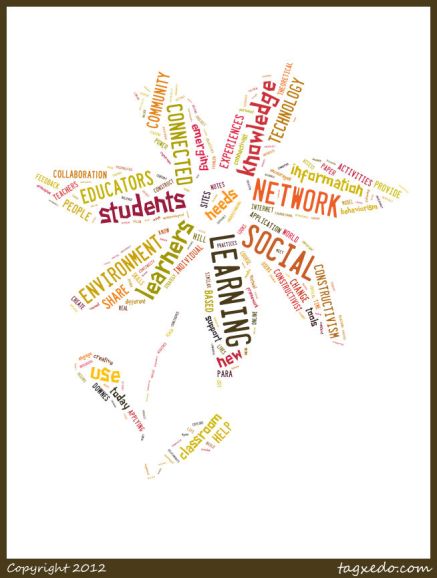 My students would find it no surprise to see yet another word cloud in my reflection. I love word clouds! They are such a creative, versatile tool that can be used for fun, nonsense, and also as a writing tool like summarizing key concepts. This Tagxedo word cloud may not look like much, but let me assure you it represents hours (DAYS!), sweat, and tears. It also represents a newly grown knowledge within me, which is really what it’s about in the first place.
My students would find it no surprise to see yet another word cloud in my reflection. I love word clouds! They are such a creative, versatile tool that can be used for fun, nonsense, and also as a writing tool like summarizing key concepts. This Tagxedo word cloud may not look like much, but let me assure you it represents hours (DAYS!), sweat, and tears. It also represents a newly grown knowledge within me, which is really what it’s about in the first place.
Specifically, this is a visual representation of my 2852-word synthesis paper draft for EdTech 504. I’ll spare you the math: that’s 8 dense, heavy, scholarly pages, not including 2.5 pages of peer-reviewed references. I don’t think I’ve ever written a paper that includes so-far 21 references. Wow.
It’s not called a synthesis paper for nothing. To synthesize is to combine, sort through, fuse, and otherwise make sense of a lot of information. I have read dozens of scholarly journals, articles, blog posts (which aren’t peer re-viewed but provide interesting context), and eBooks. I’ve scoured the APA Style Guide and become good friends again with Zotero.
This is not light reading, by the way. It is heavy stuff that includes words I knew little about before starting this course, words like constructivism, connectivism, taxonomy, and epistemology.
Yet, 2852 words later, I have a much better handle on it all. In fact, what was so utterly confusing and aggravating when I was in the thick of it, actually makes sense. I think I get it, at least as it pertains to my limited focus. Here’s the plain English:
More and more teachers are using Virtual Learning Environments (VLE) social network learning sites such as Edmodo, Schoology, Moodle, Blackboard, and Canvas. These sites provide a controlled environment where teachers and students interact, post and submit homework, give and receive feedback from their peers, and link to course resources and information. Social network learning, which by the way is distinctly different pedagogically than social networking, is like a walled-garen that helps students learn critical skills while in a safe and controlled environment.
Most of us know and love social media, and it is an integral part of our lives. How, then, can this desire to be connected, to be part of something greater than ourselves, translate into the classroom? Should we really require that our students completely “disconnect” when they come to school from their real lives and the tools that are integral to their very existence?
My paper supports the use of intentional, planned, purposeful social learning networks to engage students in the classroom. It attempts to “define social network learning and its theoretical connectivist foundations, and provides learning strategies to apply such pedagogy in the classroom.” Basically, it is the why of using social network learning strategies.
I look at social network learning through connectivist principles, and explore practical applications such as Virtual Learning Environments, Learning Communities, and Project-Based Learning. I explore traditional learning theories and emerging learning theories (theory or framework debate) and use these to argue the critical need of using social networks in the classroom.
I have long been a believer in helping students make connections, of giving them a larger audience, of equipping them with the skills that govern online social behavior while we still have them in our reach. Now I have a basis for this belief, and I’ve emerged with an even greater commitment. Since technology has “reorganized how we live, how we communicate, and how we learn” (Siemens, 2004), shouldn’t we, as educators, be willing to help our students make some sense of it all? Use it? Benefit from it?
I believe we should.
Connectivism, at its heart, holds that rather than transferring, making, or building knowledge, it is more like “growing or developing ourselves and our society in certain (connected) ways” (Downes, 2007, para. 6).
As my word cloud flower proves, new knowledge has certainly grown within me.
References:
Downes, S. (2007, February 3). What connectivism is. Half an Hour. Blog. Retrieved from http://halfanhour.blogspot.com/2007/02/what-connectivism-is.html
Siemens, G. (2004). Connectivism: A theory for the digital age. Retrieved from http://www.elearnspace.org/Articles/connectivism.htm
